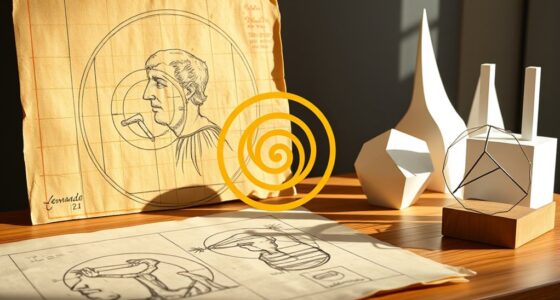Traditional quilts showcase intricate tessellations and geometric patterns that reflect cultural stories and artistic skill. You’ll notice how repeating shapes like triangles and squares interlock seamlessly, symbolizing unity and harmony within communities. These designs often carry cultural meanings through colors and motifs, turning quilting into a language of storytelling. Exploring these patterns reveals a rich blend of math, craftsmanship, and cultural identity—continue exploring to discover the deeper connections woven into each quilt.
Key Takeaways
- Traditional quilts often feature tessellations with repeating geometric shapes, showcasing craftsmanship and mathematical principles.
- Quilt patterns use symmetry and interlocking designs that symbolize cultural values like unity and harmony.
- Geometric motifs in quilts reflect cultural stories, beliefs, and social meanings through specific shapes and colors.
- Handmade quilting involves deliberate tessellations that demonstrate artistic expression and cultural heritage.
- Recognizing geometric patterns in quilts deepens appreciation for their artistic, cultural, and storytelling significance.

Have you ever noticed how traditional quilts often feature intricate patterns that seem to fit together perfectly? These designs are more than just pretty visuals; they’re a testimonial to the skill and creativity woven into fiber arts. When you examine these quilts closely, you’ll see that they utilize tessellations—repeating geometric shapes that interlock seamlessly—creating mesmerizing motifs that seem to come alive with each stitch. This clever use of geometry isn’t accidental; it’s a deliberate technique that connects the craft of quilting with math, art, and storytelling.
Traditional quilts showcase tessellations—interlocking geometric shapes that blend math, art, and storytelling seamlessly.
In many cultures, these patterns carry deep cultural symbolism, reflecting beliefs, histories, and social values. As you study different quilts, you’ll recognize that the shapes and colors often symbolize important ideas or traditions. For example, certain motifs might represent fertility, protection, or community bonds. The choice of colors can also convey specific meanings—red for life and vitality, blue for tranquility, or white for purity. These symbolic elements transform a simple blanket into a narrative, a visual language that communicates cultural identity across generations.
The fiber arts involved in quilt-making serve as a crucial medium for expressing cultural symbolism. Each piece you see is crafted with intention, often passed down through families or communities. The stitching, fabric choices, and pattern arrangements are carefully selected to honor heritage and tell stories. Many traditional quilts are handmade, involving painstaking craftsmanship that highlights the connection between artisans and their cultural roots. This process transforms raw materials into meaningful art, bridging personal memory and collective history.
Moreover, quilts often incorporate tessellations that are rooted in the mathematical principles of symmetry and repetition. These geometric patterns are not only aesthetically pleasing but also serve as a form of cultural expression. They demonstrate how humans have used basic shapes—triangles, squares, hexagons—to create complex, interlocking designs that symbolize unity and harmony. When you observe these patterns, you’re witnessing a fusion of artistry and mathematical ingenuity, passed down through generations as part of cultural storytelling. Additionally, recognizing the symmetry principles behind these tessellations enhances your understanding of how geometric concepts are embedded in traditional craft.
Ultimately, traditional quilts are more than functional objects—they’re cultural artifacts. They embody a rich history of fiber arts intertwined with symbolism that conveys deeper meanings. Recognizing the geometric precision behind these tessellations helps you appreciate the craftsmanship and cultural significance embedded in each stitch. Every quilt tells a story, not just through its patterns and colors but through the cultural symbolism that makes each piece unique and meaningful.
Frequently Asked Questions
How Do Cultural Influences Shape Quilt Patterns Worldwide?
You see how cultural influences shape quilt patterns worldwide by incorporating cultural symbolism and regional motifs that reflect local traditions and beliefs. These elements influence the choice of colors, shapes, and designs, making each quilt unique to its community. You can notice how these patterns tell stories, honor ancestors, or symbolize natural elements, connecting people through shared cultural identity and preserving heritage through intricate, meaningful designs.
What Mathematical Principles Underlie Complex Quilt Tessellations?
You see that complex quilt tessellations rely on mathematical principles like symmetry groups and geometric transformations. These principles help you create repeating patterns that fit together seamlessly, using rotations, reflections, and translations. By understanding symmetry groups, you can design intricate, harmonious designs. Geometric transformations allow you to manipulate shapes, ensuring your quilt patterns are both visually appealing and mathematically precise, making your quilt truly a work of art.
Are There Specific Tools Used for Designing Tessellated Quilt Patterns?
Imagine you’re a modern quilt artist, and yes, you do use specific tools for designing tessellated quilt patterns. Quilt design software helps you create intricate, precise patterns digitally before cutting fabric. Fabric cutting tools, like rotary cutters and rulers, guarantee your pieces fit perfectly. These tools streamline your process, making complex tessellations achievable and allowing your creativity to shine through every detailed, mathematically inspired design.
How Has Digital Technology Impacted Traditional Quilting Techniques?
Digital technology has transformed traditional quilting by making design and execution easier. You can now use digital embroidery tools to create intricate patterns with precision, saving time and reducing errors. Online quilting communities provide inspiration, tutorials, and advice, helping you improve your skills and share your work. These advancements make quilting more accessible, allowing you to experiment with new patterns and techniques while preserving the rich heritage of folk art.
Can Tessellations Be Found in Other Folk Art Forms Globally?
Yes, tessellations turn up in folk art worldwide, weaving cultural symbolism and textile motifs into mesmerizing patterns. You’ll find these geometric designs in African beadwork, Islamic tilework, and Native American textiles, each echoing unique traditions and stories. These tessellated motifs serve not just decorative purposes but also symbolize spiritual beliefs, community bonds, and cultural identities. Exploring global folk art reveals how tessellations beautifully blend art, symbolism, and storytelling across cultures.
Conclusion
As you explore traditional quilts and tessellations, you’ll see how they weave geometry into everyday art like colorful threads in a tapestry. These patterns are like a dance of shapes, each piece fitting perfectly into the next, creating a visual symphony. By understanding their geometric roots, you can appreciate how folk art transforms simple shapes into masterpieces. So, next time you see a quilt, remember you’re gazing at a beautiful puzzle where math and art come together like old friends.









